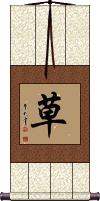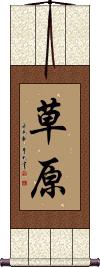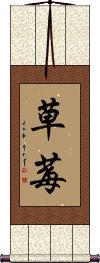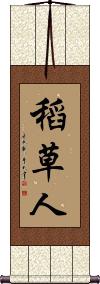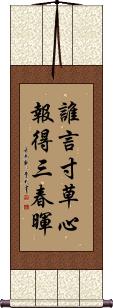Many custom options...
And formats...

Cao3 in Chinese / Japanese...
Buy a Cao3 calligraphy wall scroll here!
Personalize your custom “Cao3” project by clicking the button next to your favorite “Cao3” title below...
Cao / Kusa / Grass
草 means grass or straw in Chinese, Japanese Kanji, and old Korean Hanja.
Depending on the context, this can also mean a manuscript, draft (of a document), or rough copy. In the botany context, it can also refer to weeds, herbs, thatch, or plants.
草 is also the first character of caoshu or sōsho, the Chinese and Japanese wild cursive script style of calligraphy.
Sometimes written in variant form 艸.
This can be the surname Sou/Sō, or the given name Kusa in Japanese (there are also other romanizations for this Kanji).
Savannah / Grasslands
This is the Chinese, Japanese Kanji, and old Korean Hanja for grassland, prairie, grass-covered plain, grasslands, meadows, Savannah, or steppe.
Sometimes also pronounced Soubaru in Japanese when used as a surname.
Strawberry
Scarecrow
Appreciation and Love for Your Parents
誰言寸草心報得三春暉 is the last line of a famous poem. It is perceived as a tribute or ode to your parents or mother from a child or children that have left home.
The poem was written by Meng Jiao during the Tang Dynasty (about 1200 years ago). The Chinese title is “You Zi Yin” which means “The Traveler's Recite.”
The last line as shown here speaks of the generous and warm spring sunlight which gives the grass far beyond what the little grass can could ever give back (except perhaps by showing its lovely green leaves and flourishing). The metaphor is that the sun is your mother or parents, and you are the grass. Your parents raise you and give you all the love and care you need to prepare you for the world. A debt that you can never repay, nor is repayment expected.
The first part of the poem (not written in the characters to the left) suggests that the thread in a loving mother's hands is the shirt of her traveling offspring. Vigorously sewing while wishing them to come back sooner than they left.
...This part is really hard to translate into English that makes any sense but maybe you get the idea. We are talking about a poem that is so old that many Chinese people would have trouble reading it (as if it was the King James Version of Chinese).
Not the results for cao3 that you were looking for?
Below are some entries from our dictionary that may match your cao3 search...
| Characters If shown, 2nd row is Simp. Chinese |
Pronunciation Romanization |
Simple Dictionary Definition |
草原 see styles |
cǎo yuán cao3 yuan2 ts`ao yüan tsao yüan sougen(p); kusahara; kusawara / sogen(p); kusahara; kusawara そうげん(P); くさはら; くさわら |
More info & calligraphy: Savannah / Grasslands(1) grassy field; grassland; meadow; (2) (そうげん only) grass-covered plain; savannah; prairie; steppe; (surname) Soubaru |
草莓 see styles |
cǎo méi cao3 mei2 ts`ao mei tsao mei |
More info & calligraphy: Strawberry |
稻草人 see styles |
dào cǎo rén dao4 cao3 ren2 tao ts`ao jen tao tsao jen |
More info & calligraphy: Scarecrow |
懆 see styles |
cǎo cao3 ts`ao tsao |
anxious; sad |
艸 草 see styles |
cǎo cao3 ts`ao tsao takakusa たかくさ |
variant of 草[cao3] (1) kanji "grass radical" (radical 140); (2) grass crown; (out-dated kanji) (1) grass; weed; herb; thatch; (2) (archaism) ninja; (prefix) (3) not genuine; substandard; (surname) Takakusa |
艹 see styles |
cǎo cao3 ts`ao tsao |
grass radical 草字頭兒|草字头儿[cao3 zi4 tou2 r5] |
三草 see styles |
sān cǎo san1 cao3 san ts`ao san tsao mitsukusa みつくさ |
(surname) Mitsukusa three grasses |
中草 see styles |
zhōng cǎo zhong1 cao3 chung ts`ao chung tsao chūsō |
Medium-sized herbs, medium capacity, v. 三草. |
乳草 see styles |
rǔ cǎo ru3 cao3 ju ts`ao ju tsao chichikusa; chichikusa ちちくさ; チチクサ |
milkweeds (genus Asclepias) (See 蘿芋) Metaplexis japonica |
乾草 干草 see styles |
gān cǎo gan1 cao3 kan ts`ao kan tsao kansou / kanso かんそう |
hay (See 干し草) hay; dry grass |
仙草 see styles |
xiān cǎo xian1 cao3 hsien ts`ao hsien tsao sensou; sensou / senso; senso せんそう; センソウ |
medicinal herb (genus Mesona); grass jelly Chinese mesona (Platostoma palustre); (given name) Sensou |
出草 see styles |
chū cǎo chu1 cao3 ch`u ts`ao chu tsao |
(of Taiwan aborigines) to go on a headhunting expedition |
割草 see styles |
gē cǎo ge1 cao3 ko ts`ao ko tsao |
mow grass |
勁草 劲草 see styles |
jìng cǎo jing4 cao3 ching ts`ao ching tsao keisou / keso けいそう |
tough upright grass; (fig.) a staunch character who is loyal despite danger and hardship wind-resistant blade of grass; resistant idea (metaphorically); (personal name) Keisou |
吃草 see styles |
chī cǎo chi1 cao3 ch`ih ts`ao chih tsao |
to graze; to eat grass |
如草 see styles |
rú cǎo ru2 cao3 ju ts`ao ju tsao |
grassy |
宿草 see styles |
sù cǎo su4 cao3 su ts`ao su tsao |
grass that has grown on a grave since last year; (fig.) grave; to have died long ago; fodder provided to animals for the night |
小草 see styles |
xiǎo cǎo xiao3 cao3 hsiao ts`ao hsiao tsao ogusa おぐさ |
(surname) Ogusa Smaller herbs, those who keep the five commandments and do the ten good deeds, thereby attaining to rebirth as men or devas, v. 三草二木. |
打草 see styles |
dǎ cǎo da3 cao3 ta ts`ao ta tsao |
to mow grass; haymaking; to write a rough draft (of an essay etc) |
本草 see styles |
běn cǎo ben3 cao3 pen ts`ao pen tsao honzou / honzo ほんぞう |
a book on Chinese (herbal) medicine; Chinese materia medica plants; medicinal herbs |
枯草 see styles |
kū cǎo ku1 cao3 k`u ts`ao ku tsao kosou / koso こそう karekusa かれくさ |
withered grass; dry grass dry grass; dead grass; hay; withered grass |
柴草 see styles |
chái cǎo chai2 cao3 ch`ai ts`ao chai tsao shibakusa しばくさ |
firewood (surname) Shibakusa |
校草 see styles |
xiào cǎo xiao4 cao3 hsiao ts`ao hsiao tsao |
the most handsome boy in the school (see also 校花[xiao4 hua1]) |
水草 see styles |
shuǐ cǎo shui3 cao3 shui ts`ao shui tsao mizukusa; suisou / mizukusa; suiso みずくさ; すいそう |
water plants; habitat with water source and grass water plant; aquatic plant; waterweed; hydrophyte; (surname) Mizugusa |
海草 see styles |
hǎi cǎo hai3 cao3 hai ts`ao hai tsao kaisou; umikusa; umigusa / kaiso; umikusa; umigusa かいそう; うみくさ; うみぐさ |
seagrass (1) marine plant; seagrass; (2) (colloquialism) (See 海藻) seaweed; (place-name) Kaisou |
淺草 浅草 see styles |
qiǎn cǎo qian3 cao3 ch`ien ts`ao chien tsao asakusa あさくさ |
Asakusa, district of Tokyo with an atmosphere of old Japan, famous for the 7th century Buddhist temple, Sensō-ji (surname) Asakusa |
潦草 see styles |
liáo cǎo liao2 cao3 liao ts`ao liao tsao |
slipshod; careless; slovenly; (of handwriting) scrawly; illegible |
煙草 烟草 see styles |
yān cǎo yan1 cao3 yen ts`ao yen tsao tabako たばこ |
tobacco (1) (kana only) tobacco (por: tabaco); cigarette; cigaret; cigar; (2) (kana only) tobacco plant (Nicotiana tabacum); (surname) Tabako |
燈草 灯草 see styles |
dēng cǎo deng1 cao3 teng ts`ao teng tsao |
the spongy, white pulp inside the stem of rush plants, used as a wick for oil lamps |
牧草 see styles |
mù cǎo mu4 cao3 mu ts`ao mu tsao bokusou / bokuso ぼくそう |
pasture; forage grass; pasturage pasture; grass; (surname) Makigusa |
Click here for more cao3 results from our dictionary
The following table may be helpful for those studying Chinese or Japanese...
| Title | Characters | Romaji (Romanized Japanese) | Various forms of Romanized Chinese | |
| Cao Kusa Grass | 草 | sou / kusa / so / kusa | cǎo / cao3 / cao | ts`ao / tsao |
| Savannah Grasslands | 草原 | sougen / kusahara sogen / kusahara | cǎo yuán / cao3 yuan2 / cao yuan / caoyuan | ts`ao yüan / tsaoyüan / tsao yüan |
| Strawberry | 草莓 | cǎo méi / cao3 mei2 / cao mei / caomei | ts`ao mei / tsaomei / tsao mei | |
| Scarecrow | 稻草人 | dào cǎo rén dao4 cao3 ren2 dao cao ren daocaoren | tao ts`ao jen taotsaojen tao tsao jen |
|
| Appreciation and Love for Your Parents | 誰言寸草心報得三春暉 谁言寸草心报得三春晖 | shuí yán cùn cǎo xīn bào dé sān chūn huī shui2 yan2 cun4 cao3 xin1 bao4 de2 san1 chun1 hui1 shui yan cun cao xin bao de san chun hui | shui yen ts`un ts`ao hsin pao te san ch`un hui shui yen tsun tsao hsin pao te san chun hui |
|
| In some entries above you will see that characters have different versions above and below a line. In these cases, the characters above the line are Traditional Chinese, while the ones below are Simplified Chinese. | ||||
Successful Chinese Character and Japanese Kanji calligraphy searches within the last few hours...
